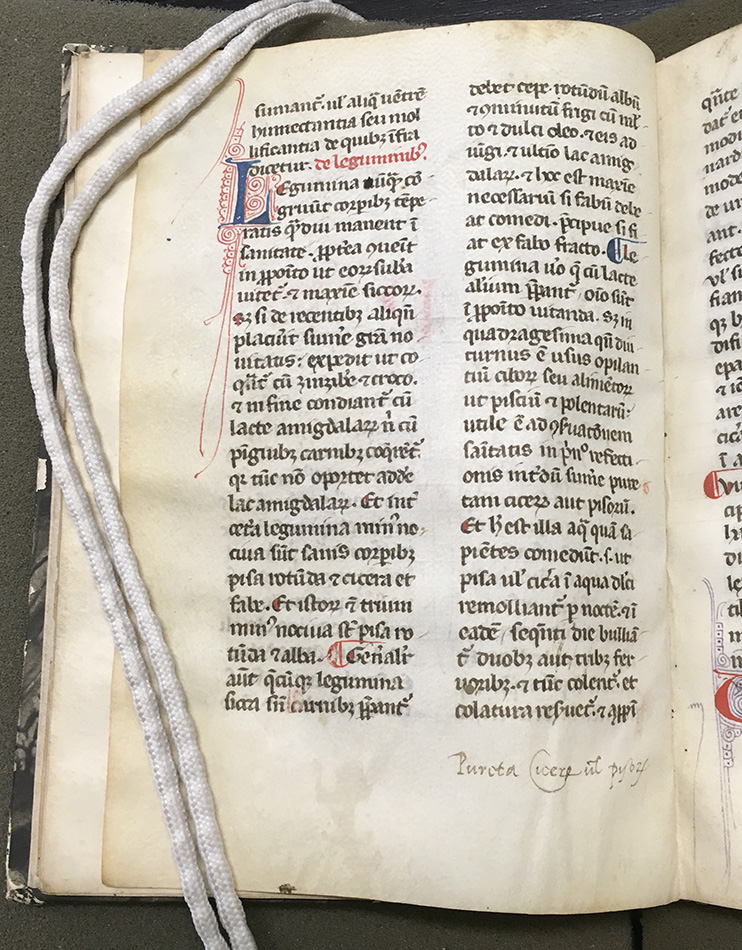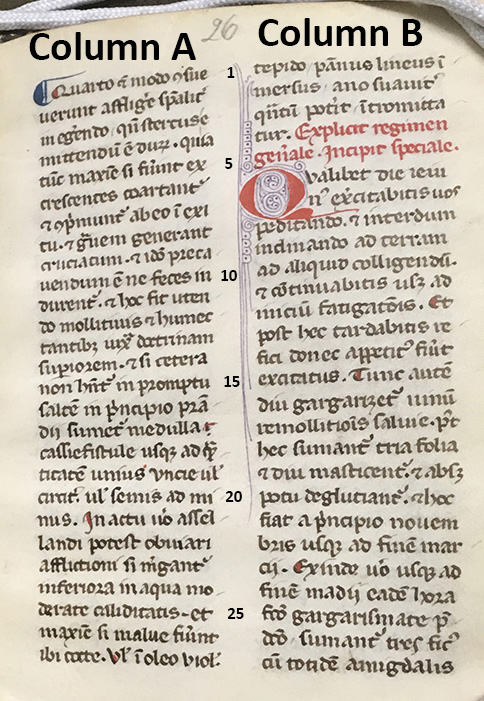Over the past few months, we’ve looked at various parts of medieval manuscripts – catchwords, ink (here and here), illuminations (here, here, and here), etc., etc. Today we are going to look at the script of 10a 210 (Arnald of Villanova’s Regimen sanitatis ad regem Aragonum).

Regimen sanitatis ad regem Aragonum. Spain or southern France; 14th century or c.1400. Call number 10a 210.
Paleography is the study of historical handwriting. The script is the style of handwriting, while hand refers to an individual scribe’s style of writing. The script of a medieval manuscript can help in dating its creation. Rather than list all the terms associated with paleography, and try to summarize the history of western scripts, I’m adding an extended sources/further reading section at the end of this post.
As I’ve mentioned before, it is not common to have a creation date written in a medieval manuscript. While the Library has a couple that are dated (see here and here), 10a 210 is not one of them. Our most recent complete bibliographic description, done by Peter Kidd in 2015, attributes 10a 210 to Spain or southern France, 14th century or circa 1400.
Peter Kidd describes the script in 10a 210 as gothic book-hand. But what does that mean? Gothic generally describes “a period of Western art that began in the late twelfth century and ended sometime between c. 1300 and the early sixteenth century, depending on the region in question and the rapidity of its response to the Renaissance.” Bookhand is used to describe “a formal script in which the pen was lifted from the page between the individual strokes of the letter.”
Gothic bookhands were used for both liturgical and secular texts, and were based on the earlier miniscule scripts. The script in 10a 210, should we want to drill down further, is a littera gothica rotunda italiana, or Italian Gothic rotunda. This script was used not only in Italy, but also Portugal, Spain, and southern France. Some features of Italian Gothic rotunda include: the letters being broader and rounder than in other Gothic scripts; m and n as the only letters whose minims (short vertical strokes used to make the letters i, m, n, and u in miniscule scripts) have a short upward stroke; the ascenders (the part of the vertical stroke that rises above the headline) of f, h, r, and long s being flat; and the descenders (the part of the vertical stroke that extends below the baseline) of p and q being flat as well.
Below is an image of f. 26r from 10a 210. Look closely and see if you can spot some other identifying features of Italian Gothic rotunda. Paleography is fun!

Regimen sanitatis ad regem Aragonum. Spain or southern France; 14th century or c.1400. Call number 10a 210.
Column a, line 4: an uncial (most popular script from the 5th – 8th centuries, basically majuscule [script in which letters are all the same height] letters) d
Column a, line 9: the 2-shaped form of r (it resembles a number 2)
Column b, line 20: an h with a rounded arm
Sources/further reading:
Brown, Michelle P. Glossary. Understanding Illuminated Manuscripts: A Guide to Technical Terms. J. Paul Getty Museum: Malibu and British Library: London, 1994. Courtesy of Michelle Brown and the British Library: https://www.bl.uk/catalogues/illuminatedmanuscripts/GlossB.asp
Cappelli, Adriano. The elements of abbreviation in medieval Latin paleography, trans. David Heimann and Richard Kay. Lawrence, Kansas: University of Kansas Libraries, 1982.
Clemens, Raymond, and Graham, Timothy. Introduction to Manuscript Studies. Ithaca, New York: Cornell University Press, 2007.
Institute of Historical Research. “InScribe: Paleography learning materials (free course).” School of Advanced Study, University of London. Undated.
Kidd, Peter. A Descriptive Catalogue of the Medieval Manuscripts in the Library of the College of Physicians, Philadelphia. 2015.
Paleo at Penn. “Paleography Resources & Tools.” Graduate Paleography Group at The University of Pennsylvania. The Schoenberg Institute of Manuscript Studies (SIMS). Undated.
Tillerson, Dianne. Medieval Writing: History, heritage, and data source. 20 February 2016.
